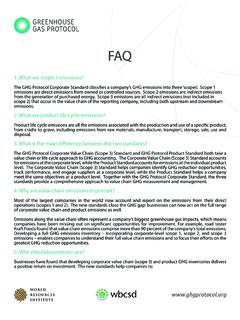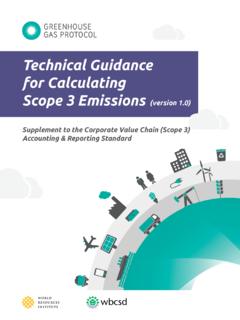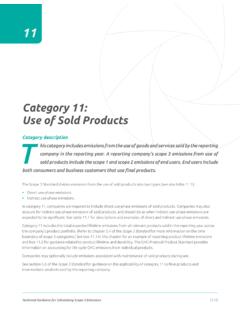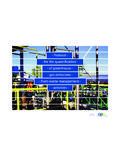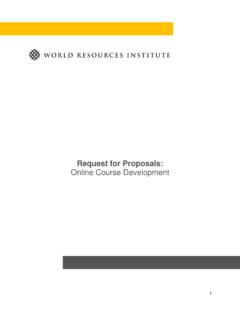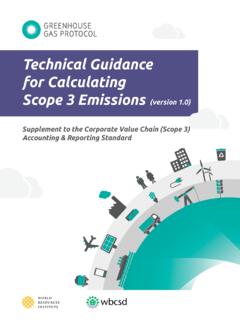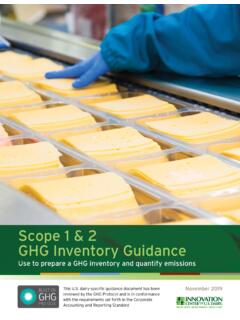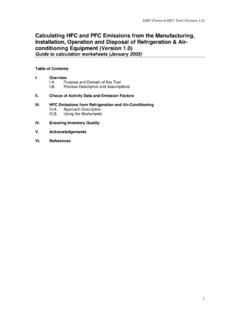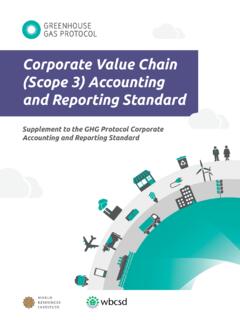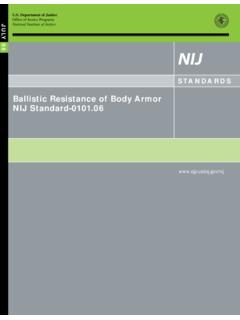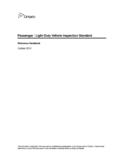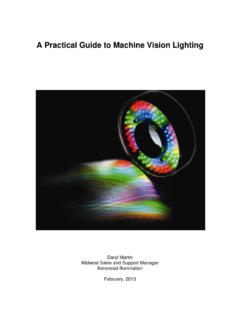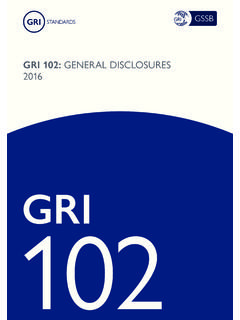Transcription of A short guide to their purpose, similarities and differences
1 Publicly Available Specification (PAS) 2050 - Specification for the assessment of the life cycle greenhouse gas emissions of goods and services was developed by the British standards Institution in 2008. PAS 2050 is the first consensus-based and internationally applicable standard on product carbon footprinting that has been used as the basis for the development of other standards internationally. The 2011 revision to PAS 2050 was developed through extensive consultation with international stakeholders, and in particular, through significant engagement with the wide PAS 2050 user community. Why are there two different standards available on product carbon footprinting? PAS 2050 was introduced in 2008 (revised in 2011) with the aim of providing a consistent internationally applicable method for quantifying product carbon footprints.
2 The GHG Protocol Product Standard was released in 2011 and in addition to providing requirements to quantify the GHG inventories of products, also includes requirements for public reporting. Both standards are broadly consistent in their quantification methods, but their differing purpose and standard development processes has lead to two different documents. How are these two standards aligned? The GHG Protocol built on the initial PAS 2050 method in development of its Product Standard. In turn, the PAS 2050 drew upon lessons learned during the Product Standard s development process in its 2011 revision. As a result of this cross collaboration, the key methodological rules underpinning quantification in both standards are consistent. In particular, key topics that have been brought into alignment include consistent approaches to: Sector or product rules Inclusion of biogenic carbon Recycling Land use change Delayed emissions Will I get a different result if I use one versus the other?
3 While both PAS 2050 and the Product Standard provide requirements for quantifying the GHG impact of a product over its lifetime, the PAS includes requirements for recording while the Product Standard includes requirements for public reporting. Additionally, while harmonization on all qualification methodologies was sought during the development of both standards , some minor differences do remain. The table below provides detail on each aspect of the methodologies, the differences between them, and estimates on whether the difference may affect the final result. Importantly, both standards provide a consistent approach to promoting the use and development of sector specific rules known as product rules in the Product Standard and supplementary requirements in PAS 2050. This approach recognises the importance that sector/product specific rules have in aiding consistent application of the standards within sectors.
4 As further sector specific rules are developed , we hope that the same rules may be applied to either standard to bring further consistency in product carbon assessments internationally. NOTE: The International standards Organisation is also developing a standard for the carbon footprint of products (ISO 14067) with whom collaboration is on-going. This factsheet is intended to be revised when ISO 14067 is published. GH G The Greenhouse Gas Protocol, a collaboration of the World Resources Institute and the World Business Council for Sustainable Development, provides the foundation for sustainable climate strategies and more efficient, resilient and profitable organizations. The GHG Protocol Product Standard is one of a suite of accounting tools developed by the GHG Protocol to encourage users to understand, quantify, and manage greenhouse gas emissions.
5 The standards follow an inclusive, consensus based multi-stakeholder process with balanced participation from businesses, government agencies, non- governmental organizations, and academic institutions around the world. QUANTIFYING THE GREENHOUSE GAS EMISSIONS OF PRODUCTS PAS 2050 & the GHG Protocol Product Standard A short guide to their purpose, similarities and differences Topic Summary of the PAS 2050 and the Product Standard methodologies (Note: this summary is not sufficient to complete an assessment/inventory for full descriptions of the requirements of each standard please see the respective documents) Implications for difference in assessment results (None = green; minor chance = yellow; some = pink) Goal, scope and principles Goal Same goals to provide consistent method to identify, understand and manage ( reduce) emissions.
6 None expected Some difference in that the PAS 2050 focuses on providing a consistent method for assessment , while the Product Standard enables organisations to account for and publicly report GHG inventories of products . None expected Principles Essentially the same drawing on two sources: ISO 14044 (PAS 2050) and the GHG Protocol Corporate Standard (Product Standard). None expected Product sector rules PAS 2050 review has introduced supplementary requirements (SRs) that include sector guidance/rules /Product Category Rules. The Product Standard refers to product rules to enable comparisons. Both documents require sector approaches to be consistent with the overarching standard. Some chance - if different SRs and/or product rules are used. But it is expected that the same rules should apply to either standard.
7 PAS 2050 sets out principles that SRs must adhere to to be applicable to the PAS. The Product Standard provides guidance on the development of product rules. None expected guidance and principles convey the same meaning. Treatment of specific emissions and removals Biogenic carbon Both require biogenic emissions and removals to be included in the assessment. None expected PAS 2050 excludes biogenic carbon for food and feed. This is on the grounds that they are short cycle products so the emissions & removals are likely to cancel each other out (and avoids the need to include CO2 emissions from animal digestion). The Product Standard includes biogenic carbon in the inventory for all products and requires separate reporting for additional transparency. None expected - The exclusion of food and feed is optional in the PAS but if it is excluded the outcome of the assessment is likely to be the same.
8 Aircraft emissions Neither standard require the use of a multiplier or other correction to emissions from aircraft transport. The Product Standard allows the use of a multiplier in the inventory results, but if so the multiplier must also be disclosed in the inventory report. If a multiplier is used for PAS 2050, it needs to be recorded separately from the main inventory result. Minor chance - the inclusion of a multiplier is optional in the Product Standard but if included would cause different results for air travel emissions. Time period for assess-ment PAS 2050 specifies 100 year assessment period, unless otherwise provided for in supplementary requirements. The Product Standard allows companies to specify the appropriate time-frame. But if known science, sector guidance, or product rules do not exist, the Product Standard suggests companies should assume a minimum time period of 100 years including the end-of-life stage.
9 Minor chance If a longer time period is used following the Product Standard. However, both standards allow flexibility for certain products/sectors. Stored carbon In both standards , carbon stored beyond the assessment period is treated as stored carbon. In the Product Standard, stored carbon is also reported separately. Minor chance - if time / assessment period is different. Delayed emissions For both standards weighting factors shall not be applied to the inventory results (but companies may include results with weighting factors separately). None expected Land use change Direct land use change is included in both documents. The Product Standard includes land use change within the inventory results and requires separate reporting for transparency. For PAS 2050 it is included within the assessment and the type and timing of land use change must be recorded.
10 None expected The PAS 2050 no longer requires to the use of worst case scenario where previous land-use unknown, allowing for average statistical data to determine direct land use change impacts. The Product Standard provides guidance for estimating direct land use change using average statistical data but also allows for the worst case scenario to be assumed None expected PAS 2050 provides some default values for land converted to cropland but reverts to IPCC for other types of land use change. The Product Standard provides guidance on how to calculate land use change emissions, following IPCC, but does not include specific default values. None expected as they both follow IPCC Indirect land use change is not a requirement in the Product Standard, but can be reported separately from the inventory results.
